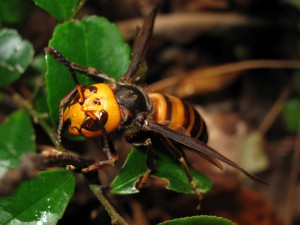Bees provide a classic example of extreme complexity within animal societies. The exact geometry of the honeycomb and hive, combined with their tendency towards clearly defined echelons and rank, suggest that highly precise and ordered mechanisms are behind the seemingly chaotic buzzing of a bee colony. Although they lack the cognitive power of a human on the individual scale, the communications and interactions of bees within their colonies demonstrate incredible and often surprising social precision. Like any complex system, from the micro scale of our own bodies to the macro of our societies, the beehive must be adaptable. And a large part of this adaptability depends upon responding quickly and effectively to predators.
When faced with a predator, bees alert their hive-mates via a vibrating head-butt, causing the target to freeze. This inhibits further waggle dancing, a visual “dance” forager bees preform to guide their compatriots to food sources. First detected in the European honey bee (Apis mellifera), this stop signal was initially assumed to be a mechanism for preventing unnecessary further recruitment to a particular flower.
Researchers in China explored responses of Asian honey bees (Apis cerena) to predatory hornets, including the small Vespa velutina and the horrifyingly massive Vespa mandarina (the largest hornet species). They found that alarm signals produced by bees, in this case both nest guards and foragers, not only alert other bees to the presence of danger, but also include coded information about the threat’s severity and location.
Bees were presented with both species of hornets at two locations: their (the bees) hive’s entrance and at a food source. The researchers recorded individual bees’ “stop signals,” looking at the head-butt’s pitch and length. They found that the larger hornets, Vespa mandarina, elicit a higher frequency stop signal, and that attacks at the nest resulted in a longer signal duration than attacks at the food source.

Apis cerana heat-balling two hornets
Bees subdue predatory hornets by forming a “heat ball,” swarming the attacker until it cooks to death. Vespa mandarina kills more bees during this heat ball maneuver than Vespa velutina, so the researchers decided it presented a greater threat to colony health. Likewise, an attack at the colony entrance is, for obvious reasons, more dangerous than attacks on isolated individual foragers. Thus, the combination of stop signal length and frequency provides graded information about the location (nest/food) and severity (big hornet/small hornet) of the attack.
Although graded threat signaling has been observed in mammals and other vertebrates, this is the first evidence of insects using this mechanism. Considering the incredible precision dictating the motions and tasks of a beehive, it should come as no surprise that bees are able to respond to threats with an adaptively appropriate level of intensity. Given their worldwide dominance as pollinators, understanding how signals among individual bees contribute to efficient maintenance of the hive system is essential for dissecting the development of social organisms.
Tan, K., Dong, S., Li, X., Liu, X., Wang, C., Li, J., & Nieh, J. C. (2016). Honey Bee Inhibitory Signaling Is Tuned to Threat Severity and Can Act as a Colony Alarm Signal. PLoS Biol, 14(3), e1002423.


I’m a pretty established beekeeper in southern California…and I didn’t know about the heat ball! What? That is an amazing piece of trivia.